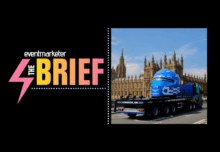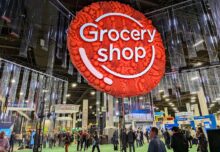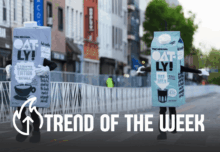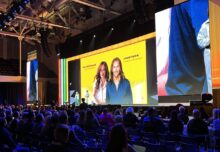 Storytelling has always been the beating heart of experiential marketing. The most memorable events immerse attendees into a story, make them part of the story and send attendees home feeling like they have a better understanding of the story the brand is trying to tell.
Storytelling has always been the beating heart of experiential marketing. The most memorable events immerse attendees into a story, make them part of the story and send attendees home feeling like they have a better understanding of the story the brand is trying to tell.
“Storytelling has always been a main component of any great event,” says Cameron Mercer, head of event marketing, EMEA, APAC and Workplace at Facebook. “It’s that connective tissue that holds your event together. It helps provide a memorable experience and something for your attendee to hold on to. Storytelling also provides the through-line for the journey for any attendee at any event. And ultimately it delivers the content that’s right for your attendee.”
Storytelling took on entirely new forms in 2020 and early 2021, and the way brands tell their stories might be changed forever by the lasting impact of the pandemic. We asked some of the top brand marketers to weigh in on what story means to them, how they are approaching their brand’s stories in the year ahead, and how they are changing course and updating their strategies to better communicate their narratives, their product stories and their cultures through live and virtual experiences.
A few things all of our panelists agreed on: You have to meet your attendees where they are. It’s always more powerful to let your customers and attendees share their stories than to ask them to listen to yours. Good content, in any form, is still good content. And the power of storytelling—especially when it’s immersive and experienced together, live—can’t be compared.
Here are excerpts from our virtual panel discussion, which have been edited for length and clarity.
THE PANELISTS:
Jitter Garcia, Head of Event Marketing at Univision Communications
Mark Henneberger, Vice President of Events Solutions at Walmart
Cameron Mercer, Head of Event Marketing, EMEA, APAC and Workplace at Facebook
Andrea Schwartz, Head of Global Event Marketing, Ripple
Teresa Terasaki, Program Manager for Brand, Experience & Events at Google Open Source
EVENT MARKETER: When the pandemic hit, many event marketers were forced to reevaluate their portfolio, their messaging and their engagement strategies. Did you use that time to rethink your brand story, or did you just have to rethink how you’re going to tell that brand story?
Cameron Mercer: Once the pandemic hit, I wouldn’t say our brand story changed; I would say it was actually enhanced. Our goal is, and always has been, to give people the power to build community and bring the world closer together. So as we moved into an environment where we needed to meet our event attendees where they were, we needed to ensure that the time that they were spending with us was incredibly valuable and that we were able to deliver on that goal by creating meaningful shared experiences. Creating inclusive, diverse and authentic stories and experiences that were valuable to hear was the most important thing, especially for our brand and our story.
Andrea Schwartz: I think what was most important for us was to take a step back and think about what was really happening in the world. The economy changed, the market changed, accessibility changed. And so we were thinking about, how are our customers doing and how are our partners handling this and how can we meet them where they are? I think it was really important to take that step back and reflect and not pretend that it was business as usual, and then create new and meaningful ways to interact with our audiences. I also think that it created an environment that brought everyone to a level playing field. The entire world was going through something at the exact same time. That’s so rare. So it wasn’t about who was ahead or what they were doing in their business. It was more making sure that people were OK. And then once we were past that, we were able to adapt and figure out, OK, now we’re all able to do this online. Let’s figure out how to make these virtual experiences as impactful as we can and create those interactive elements online since we aren’t able to be in person.
Teresa Terasaki: First of all, our audience sentiment changed. We needed to carefully learn their state of mind and adjust our strategy accordingly, what they were looking for after the pandemic. If the answer was no more events, then we were OK not to do events. Then we saw that our audience was impacted and productivity was way down. In some open source projects, we saw a 38 percent drop in daily activity. So to understand what the community is looking for, we took a survey and we learned that virtual events were the most popular channel for them to stay up to date on projects. So we decided to make one. We had to launch something quickly so we looked inside of Google to find existing resources we could use immediately. We have experts across the company who are working on open source projects. We also have ready-to-use virtual platforms, YouTube livestream and Google Meet. So we decided to combine those three and create a virtual community. The story we wanted to share is about caring, helping and empowering our audience, creating learning opportunities for them.
Jitter Garcia: Six weeks before our event was supposed to happen in 2020, we had to pivot to virtual and it was an opportunity to bring us back to our roots and remember that our content is king. And in those moments when you don’t know what to do, going back to content is king is going to be your guiding light. So, instead of having a splashy virtual event, we ended up doing two different events, one in May, that was a business update paired with a research event that was about the secrets of Spanish-language advertising. It was a short-and-sweet business message paired with a value-add that was something people hadn’t heard before and was insights and data-driven as opposed to the splash of what we typically would have done for the main upfront. And then about four weeks later, we hosted a June event that was similar to what we would have hosted at the in-person upfront with a business presentation that highlighted content. That is where we were able to hit our brand story about how important Univision is to the Hispanic community, especially during that time.
Mark Henneberger: Obviously the pandemic shook up the world, shook us up… but I believe that if you have a compelling story or you have a compelling theme, good content works, whether it’s at a live event or it’s a virtual event. At the end of the day, if you have a good story, if you have good content, it’s going to cut through.
“Whether in person or online, customer speakers are an incredibly powerful way to tell a story on our behalf. Enabling our customers to have that opportunity to speak about their partnership with us speaks volumes beyond how we could do it ourselves. Whether that is in a sponsored setting or allowing them to speak on our stage at hosted events, providing them that opportunity is a really powerful way to tell the story from beginning to end.” –Andrea Schwartz
EM: What were some of the biggest content lessons you learned in the wake of 2020 and how is that shaping how you will approach storytelling through events moving forward?
TT: After all of our events moved to virtual, we learned that some people strongly prefer in-person events over virtual events, but some people actually prefer virtual events. And that was a good finding for us—it was good that we could identify those needs. And if we move on to hybrid events, we need to compensate for what virtual events are lacking. Or if we are fully global online, we have to be mindful about the audience’s time zone, for example, and host the events in three different time zones and live stream that recording in EMEA and APAC in their time zone the next day. And we may want to create an extra chat room where virtual attendees can talk to each other and share comments while the live stream is happening. If we are distributing swag to 500 attendees at an in-person event, why not for the livestream viewers? We may want to consider shipping 500 [kits] to top livestream viewers at the virtual event, or we may want to distribute food delivery discount codes for our virtual attendees so that their lunch can be taken care of and they can focus on our events. So we have to make sure both attendees in-person and virtual can enjoy and fully maximize their experience.
CM: I think we’ve learned that the creative bar has been raised in virtual, and it’s not only how people view and scale and absorb content, but the innovations we can do and the things we can try and the stories that we can tell… we’ve learned shorter, succinct stories land well in a time-poor environment. People don’t have a ton of time. We’ve learned that on demand is in demand, as people can watch at their own pace. And we’ve learned that being diverse and inclusive and always authentic is the most important. So, you know, telling the real life story is the best story you can tell, bringing them content that helps them stay connected and ready for the future is the best thing you can do. And I think that we’ll see that moving forward with the hybrid model. It will be important because people are going to continue to be a need to be flexible as working environments change.
 More post-COVID insights:
More post-COVID insights:
- Research: 15 Data Points on the State of Experiential and Where It’s Headed
- Producing In-person Events Post-COVID: Nine Resources for Event Marketers
MH: We learned that the reach of these events is accelerated. It’s not cascading where a store manager goes through the event and goes back to a store and tells what he learned to the store. Associates can learn it at the same time. So it’s really increased our audiences tremendously. We could give them a sense of being part of this big company that cares about its people and the communities that they serve.
AS: This is not new, but more than ever content is king. We always knew that the topics and the speakers would drive people committing to an event, but without the physical event to show up to, and the commitment of the expensive ticket and a plane fare and a hotel, it’s really about the content that they’re going to hear and the takeaways that they’re going to walk away with at the end of the event. So I think it really refocused our attention on what we were trying to convey. What are the success metrics and what do we want people to walk away with at the end of the day? And I definitely think that will continue on as we go back to live events.
I also think TED Talks were onto something awhile back. And I wonder if those kinds of new punchy formats will continue. I think there is a world in which hybrid events are the future, or when we’re back in person, there’s an online element because I realized that people now know that they don’t have to go to everything, especially parents or caretakers or people who have very global teams. So back to meeting people where they are, there’s probably going to still have to be an online element. And how do we combine those two worlds looking forward to create the best experience that we can while still creating the environment to have that kind of “content-is-king” moment, getting the best speakers in the best setting to make the best experience for attendees.
“No matter how technologically advanced we get, how many stores we build, how great we are in e-commerce, it just comes down to our people. Giving our people the chance to tell their story as part of a collective is really powerful and something that we always try to do.” –Mark Henneberger
EM: A lot of event marketers have been pleasantly surprised by the effectiveness of the virtual engagements they deployed and their ability to keep their story alive. Were you surprised?
JG: A lot of the events we’ve done this year, honestly, have been big surprises in how successful they’ve been. I’m a very optimistic person and I’m pretty bullish on taking risks, but I was nervous because we’ve never done it before, so there’s always that risk factor that you have to take into account. I’ve been pleasantly surprised by how impactful virtual events can be, if you’re really strategic about the timing. And again, [focusing on] the goals and understanding what it is that your attendees or your clients who are attending are looking to get out of it. Prior to the pivot, I was very, very cynical about anything virtual, thinking I would never attend a four-day conference virtually. And of course afterwards I was pleasantly surprised that more often than not, we’d had a really great response to the things that we were planning virtually.
EM: How will you immerse attendees into your brand stories moving forward?
CM: I think we believe a hybrid model for events will be the future. I think the creative bar is high and content and events are everywhere that we are, whether it’s working from home, whether you’re in the office, whether you’re in the car, picking up your kids from school, whatever you’re doing, content is there. And so I think we’ll look to create community across multiple channels and continue to provide valuable and meaningful stories and moments for our attendees, but also we need to make sure that we’re flexible with that. So I think that’s a trend that is definitely going to continue… and I don’t think virtual is going anywhere anytime soon. I think we’ll see hybrid and an exciting future because the creativity is there.
MH: I truly believe that we will never go back to 100 percent in-person events. There’s always going to be a virtual component, whether we call hybrid “omni,” whatever the buzzword becomes, because there’s just going to be people that aren’t comfortable traveling. And it’s going to be for a while. And I think we found the value that when you are able to tell your story to a broader audience, it’s actually better for the company. It’s better for the folks who work at the company. So increasing the audience, regardless of the size of the in-person audience, I think is going to be really important. And we’re going to have to make sure that we don’t just put a camera in front of a podium and that’s the content that we’re going to send out there. We actually have to think through it. And how do you make that experience if you’re not there as close to “being there” as you can. That’s going to be the next challenge for us.
Featured photo credit: erhui1979
This story appeared in the June 2021 issue





